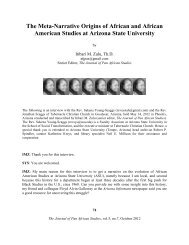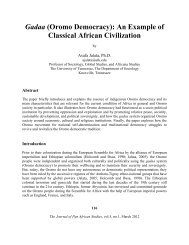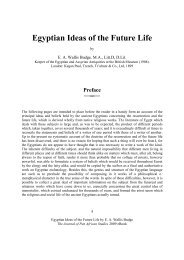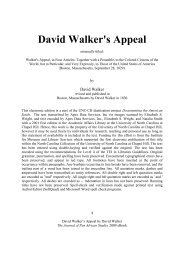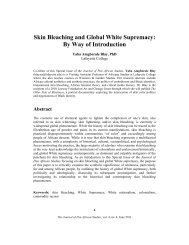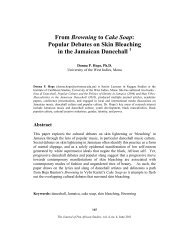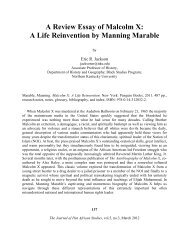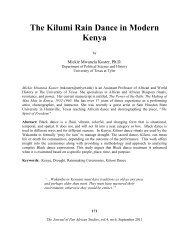The Adaptation of Swahili Loanwords From Arabic - Journal of Pan ...
The Adaptation of Swahili Loanwords From Arabic - Journal of Pan ...
The Adaptation of Swahili Loanwords From Arabic - Journal of Pan ...
You also want an ePaper? Increase the reach of your titles
YUMPU automatically turns print PDFs into web optimized ePapers that Google loves.
In terms <strong>of</strong> OT, we can use the following constraints to show this kind <strong>of</strong> syllabification: DEP-C,<br />
PEAK, and NOCODA.<br />
Input: / ͻa / PEAK NOCODA DEP-C<br />
a. � ͻ.a<br />
b. ͻ.la *!<br />
c. ͻl.a *! *<br />
Also, a preconsonantal nasal functions as a syllabic peak. <strong>The</strong> nasals that function as peaks in<br />
Kiswahili are /m/ and /n/. Examples are shown below:<br />
(5) mtu /m.tu/ ‘person’<br />
nne /n.nɛ/ ‘four’<br />
nchi /n.či/ ‘country’<br />
In syllabifying the above nasals as PEAKS we violate ONSET but avoid NOCODA violation.<br />
Using the first word /m.tu/, it is possible to show that sometimes syllable and morpheme<br />
boundaries coincide; for example, /m/ is a noun class prefix in singular form for people and<br />
animals while /tu/ is the root <strong>of</strong> the word that means ‘person’. <strong>The</strong> syllable therefore functions in<br />
the demarcation <strong>of</strong> morpheme edges and in defining the position and shape <strong>of</strong> affixes.<br />
It is important to state that a number <strong>of</strong> scholars ( Polome 1967:50; Myachina 1991:12;<br />
Mohammed 2001:11) have observed that Kiswahili has open syllables. This seems to suggest<br />
that there is NOCODA in Kiswahili syllables because the morphological structure <strong>of</strong> the<br />
language does not permit it. When loanwords are adapted into this language, it is difficult to<br />
maintain this position. <strong>The</strong> incorporation <strong>of</strong> loanwords into Kiswahili has resulted in an<br />
expansion <strong>of</strong> the Kiswahili syllabry, that is, it has increased the use <strong>of</strong> other syllable structures<br />
which are not very common in this language such as CCV and CCCV.<br />
In that vein, we can say that another syllable structure that is found in Kiswahili is a cluster <strong>of</strong><br />
two consonants with a vowel. This type is usually restricted to syllables with either a nasal as the<br />
first consonant or the approximants /j/ or /w/ as the second consonant. Here are examples <strong>of</strong><br />
words:<br />
(6) ngamia /ŋga.mi.a/ ‘camel’<br />
mwezi /mwɛ.zi/ ‘moon’<br />
twanga /twa.ŋga/ ‘pound’<br />
50<br />
<strong>The</strong> <strong>Journal</strong> <strong>of</strong> <strong>Pan</strong> African Studies, vol.2, no.8, March 2009



